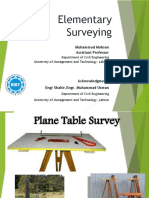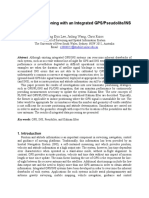Plane Table Survey: General
Uploaded by
Teguh OktaprimaPlane Table Survey: General
Uploaded by
Teguh OktaprimaSWC 211 Soil and Water Conservation Engineering
PLANE TABLE SURVEY
General: In case of plane table survey, the measurements of survey lines of the traverse and their plotting to a suitable scale are done simultaneously on the field. Following are the cases in which the plane table survey is found to be useful: (1) Compass survey cannot be carried out with success in industrial areas of the town. Plane table survey will be the best alternative in such cases. (2) For preparing plans on a small scale, plane table survey proves to be speedy, easy and accurate. (3) The city or town has expanded within two or three decades and it is required to plot the developed area on the previously plotted plan of the existing area. Instruments required: Alidade, Drawing board, Plumbing fork, Spirit level and Trough compass Temporary adjustments of plane table: Following three distinct operations at each survey station are carried out for the temporary adjustments of a plane table. (1) Centering (2) Leveling (3) Orientation (1) Centering The legs of tripod are well spread out to get the convenient height for working on the board. Then, the operation of centering is carried out by means of plumbing fork or U-frame and plumb bob. This process ascertains the fact that the point on paper represents the station point on ground. The pointed end of the plumbing fork is kept on point on paper and at the other end, a plumb bob is fixed. The table or board is shifted bodily till the plumb bob hangs exactly over the peg of the station. (2) Leveling The process of leveling is carried out with the help of spirit level and it consists of making the table level either by ordinary tilting the board or by ball and socket arrangement or by adjusting the legs of tripod. (3) Orientation
Department of Soil & Water Conservation Engineering
SWC 211 Soil and Water Conservation Engineering
The process by which the position occupied by the board at various survey stations are kept parallel is known as the orientation. Thus, when a plane table is properly oriented, the lines on the board are parallel to the lined on ground which they represent. The methods of orientation are: (i) Orientation by magnetic needle: In this method, the magnetic north is drawn on paper at a particular station. At the next station, the trough compass is placed along the line of magnetic north and then the table is turned in such a way that the ends of magnetic needle are opposite to the zeros of the scale. The board is then fixed in position by clamps. This method is inaccurate in the sense that the results are likely to be affected by the local attraction. (ii) Orientation by back sighting: In this method, the orientation is carried out by the back sighting of a particular line. Suppose a line is drawn from station A on paper representing line AB on ground. The table is centered and leveled at station B and then the alidade is placed along the line ba. The table is turned till the line of sight bisects the ranging rod at A. The board is then clamped in this position. This method is better than the previous one and it gives perfect orientation. Methods of plane table survey: Following are the four methods by which an object might be located on paper by plane table: (1) Radiation (2) Intersection (3) Traversing (4) Resection
Department of Soil & Water Conservation Engineering
SWC 211 Soil and Water Conservation Engineering
RADIATION
This is the simplest method and it is useful only when the whole traverse can be commanded from a single station. The procedure is as follows: (i) (ii) (iii) (iv) (v) Select a point P so that all the corners of the traverse ABCD are seen. Carry out the usual temporary adjustments of centering and leveling. Mark the north line on paper. Put the alidade on point P and dram a line of sight for station A. Measure the distance PA on ground and put this length to a suitable scale on paper which will give point a. Similarly, obtain points b, c and d on paper by drawing lines of sight for stations B, C and D and measuring the distances PB, PC and PD on ground respectively. (vi) (vii) Join points a, b, c and d on paper, as shown in figure. For checking the accuracy of work, measure the distances AB, BC, CD and DA on ground and compare them with the lengths ab, bc, cd and da respectively on paper.
Department of Soil & Water Conservation Engineering
SWC 211 Soil and Water Conservation Engineering
B
a b
d c
C
Radiation method
Department of Soil & Water Conservation Engineering
SWC 211 Soil and Water Conservation Engineering
INTERSECTION
This method is useful where it is not possible to measure the distances on ground as in case of a mountainous country. Hence, this method is employed for locating inaccessible points, the broken boundaries, rivers, fixing survey stations, etc. procedure is as follows: (i) (ii) Select two stations P and Q so that the points to be located on paper are easily seen from them. Plot the line pq, which is known as the base line, on paper. This can be done in one of the two ways: a. The table can be centered and leveled at station P and then after orienting at station Q, the distance PQ can be accurately measured and put up to some scale on the paper. b. The line pq can be drawn to some scale on the paper and then the board can be adjusted from station P by back sighting at station Q. (iii) (iv) (v) (vi) From station P, draw rays for stations A, B, etc. Shift the table to station Q and after proper orientation, take rays of stations A, B etc., The intersection of rays from stations P and Q will give points a, b etc. on paper, as shown in figure. For checking the accuracy of work, measure the distance AB on ground and compare it with its corresponding length ab on paper. The
Department of Soil & Water Conservation Engineering
SWC 211 Soil and Water Conservation Engineering
A B
a Plane Table p q p
q Base line
Intersection method
Department of Soil & Water Conservation Engineering
You might also like
- Night Photography - From Snapshots To Great Shots100% (4)Night Photography - From Snapshots To Great Shots346 pages
- Study and Use of Surveying and Leveling Instruments: SWC 211 Soil and Water Conservation EngineeringNo ratings yetStudy and Use of Surveying and Leveling Instruments: SWC 211 Soil and Water Conservation Engineering2 pages
- 3plane Table Survey and Tacheometric Survey PDFNo ratings yet3plane Table Survey and Tacheometric Survey PDF117 pages
- Fundamental of Soil Water Conservation Eng (1)No ratings yetFundamental of Soil Water Conservation Eng (1)73 pages
- Unit 5 Plane Table Survey Orientation Radiation Intersection Traversing Resection Two Three Point Problem Area Volume Calculation 2021 2No ratings yetUnit 5 Plane Table Survey Orientation Radiation Intersection Traversing Resection Two Three Point Problem Area Volume Calculation 2021 255 pages
- Plane Table Survey Plane Table Survey: Unit-III Unit-IIINo ratings yetPlane Table Survey Plane Table Survey: Unit-III Unit-III81 pages
- unit-5-plane-table-survey-orientation-radiation-intersection-traversing-resection-two-three-point-problem-area-volume-calculation-2021No ratings yetunit-5-plane-table-survey-orientation-radiation-intersection-traversing-resection-two-three-point-problem-area-volume-calculation-202156 pages
- Civ 3305 Engineering Surveying I AssgnmentNo ratings yetCiv 3305 Engineering Surveying I Assgnment11 pages
- Kinematic Positioning With An Integrated GPS/Pseudolite/INS: Hung Kyu Lee, Jinling Wang, Chris RizosNo ratings yetKinematic Positioning With An Integrated GPS/Pseudolite/INS: Hung Kyu Lee, Jinling Wang, Chris Rizos12 pages
- Operate A Mini Eyesafe Laser Infrared Observation Set, ANPVS-6No ratings yetOperate A Mini Eyesafe Laser Infrared Observation Set, ANPVS-68 pages
- Leica Geosystems Metrology Products Catalog 2011 enNo ratings yetLeica Geosystems Metrology Products Catalog 2011 en74 pages
- Star Adventurer Mini User Guide: Astrophotography Time-Lapse Photography DSLR Camera ControlNo ratings yetStar Adventurer Mini User Guide: Astrophotography Time-Lapse Photography DSLR Camera Control46 pages
- Download ebooks file The Demon s Design 1st Edition Christopher Nuttall all chapters100% (5)Download ebooks file The Demon s Design 1st Edition Christopher Nuttall all chapters40 pages
- Visual Storytelling The Digital Video Documentary - Original PDF100% (2)Visual Storytelling The Digital Video Documentary - Original PDF44 pages
- Interior Laser Tools Brochure LP51 LT20 LT52 LT56 LT58No ratings yetInterior Laser Tools Brochure LP51 LT20 LT52 LT56 LT584 pages
- RTI Scatter Probe: 10 and 100 CM Scatter and Leakage Detector in OneNo ratings yetRTI Scatter Probe: 10 and 100 CM Scatter and Leakage Detector in One2 pages
- Total Edge Management System: When It's CriticalNo ratings yetTotal Edge Management System: When It's Critical8 pages
- Study and Use of Surveying and Leveling Instruments: SWC 211 Soil and Water Conservation EngineeringStudy and Use of Surveying and Leveling Instruments: SWC 211 Soil and Water Conservation Engineering
- Unit 5 Plane Table Survey Orientation Radiation Intersection Traversing Resection Two Three Point Problem Area Volume Calculation 2021 2Unit 5 Plane Table Survey Orientation Radiation Intersection Traversing Resection Two Three Point Problem Area Volume Calculation 2021 2
- Plane Table Survey Plane Table Survey: Unit-III Unit-IIIPlane Table Survey Plane Table Survey: Unit-III Unit-III
- unit-5-plane-table-survey-orientation-radiation-intersection-traversing-resection-two-three-point-problem-area-volume-calculation-2021unit-5-plane-table-survey-orientation-radiation-intersection-traversing-resection-two-three-point-problem-area-volume-calculation-2021
- Kinematic Positioning With An Integrated GPS/Pseudolite/INS: Hung Kyu Lee, Jinling Wang, Chris RizosKinematic Positioning With An Integrated GPS/Pseudolite/INS: Hung Kyu Lee, Jinling Wang, Chris Rizos
- Operate A Mini Eyesafe Laser Infrared Observation Set, ANPVS-6Operate A Mini Eyesafe Laser Infrared Observation Set, ANPVS-6
- Leica Geosystems Metrology Products Catalog 2011 enLeica Geosystems Metrology Products Catalog 2011 en
- Star Adventurer Mini User Guide: Astrophotography Time-Lapse Photography DSLR Camera ControlStar Adventurer Mini User Guide: Astrophotography Time-Lapse Photography DSLR Camera Control
- Download ebooks file The Demon s Design 1st Edition Christopher Nuttall all chaptersDownload ebooks file The Demon s Design 1st Edition Christopher Nuttall all chapters
- Visual Storytelling The Digital Video Documentary - Original PDFVisual Storytelling The Digital Video Documentary - Original PDF
- Interior Laser Tools Brochure LP51 LT20 LT52 LT56 LT58Interior Laser Tools Brochure LP51 LT20 LT52 LT56 LT58
- RTI Scatter Probe: 10 and 100 CM Scatter and Leakage Detector in OneRTI Scatter Probe: 10 and 100 CM Scatter and Leakage Detector in One





























































































